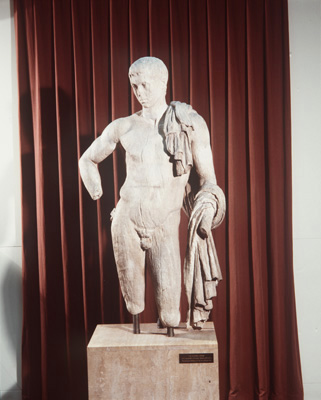The statue was donated by the sons of Sir Charles Nicholson to celebrate the centenary of the arrival of their father to Australia in 1834. It is said to have been 'found near Smyrna (Izmir)' in Turkey.
Nicholson Museum
The Museum was founded in 1860 by Sir Charles Nicholson, Chancellor of the University from 1854 to 1862. By writing to antique dealers abroad during the 1840s and 1850s Nicholson built up a collection of antiquities from all over western Europe. In the enlightened belief that it would be of greater value in Australia than in Europe, he donated to the University his collection of some 400 Egyptian antiquities, about 100 Greek vases, and some prehistoric, Etruscan and Roman objects. These formed the basis for what became known as the Nicholson Museum, now an archaeological collection unique in Australia comprising five collections: Near Eastern, Cypriot, Classical (Greek and Roman), European and Egyptian.
The museum's current temporary exhibition is entitled "From Pella to Petra: Australian archaeologists in Jordan." It highlights the work of Australians in the Kingdom of Jordan over the last 50 years and features many objects from the university's own excavations. The exhibition runs until the end of 2002.
Items
Statue
The Nicholson Hermes

Ceramic Amphora
The Antimenes Amphora

On the reverse, Dionysos with satyrs and maenads.
Statue
Horemheb
The statue was purchased by Sir Charles Nicholson from a Cairo dealer in1862. It belonged to a seated or standing figure, possibly set up in Horemheb's Saqqara tomb or the Ptah Temple at Memphis.
Egyptian Coffin
Coffin of Padiashakhet
The museum also holds the mummy of Padiashakhet, which has been the subject of detailed scientific study. The mummy is not on display.
